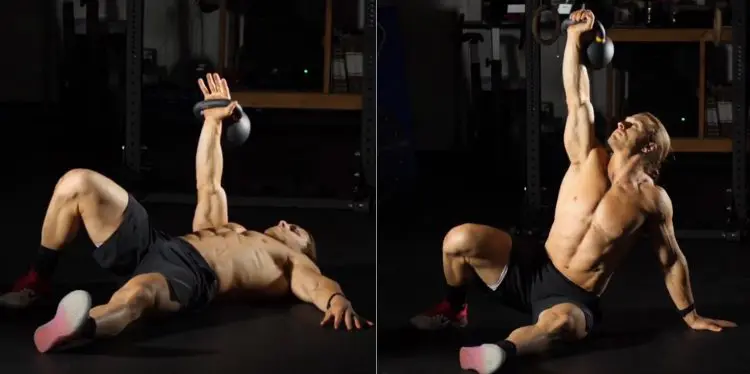When it comes to core and abs training, many people tend to focus on isolation exercises like crunches, sit-ups, and leg raises. In many ways, this makes a lot of sense because training your midsection muscles on their own means you can really focus on them, feeling every rep you perform.
However, while such an isolated approach is good for improving the aesthetics of a muscle, it is not necessarily the best way to improve its function. That’s because, in nature, no muscle works alone. Even simple movements are the result of lots of muscles contracting and relaxing together.
Take your hamstrings, for example. The only time you do a movement that even vaguely resembles a seated leg curl is when you pull the footrest in on your reclining chair! The rest of the time, your hamstrings work with your glutes to extend your hip AND flex your knee, such as when you walk, run, or deadlift.
Your abs are much the same. The only time you do a crunch out in the real world is when you sit up in bed. The rest of the time, your core muscles work with your arms and legs, usually stabilizing your spine.
So, while there is nothing wrong with working your abs in isolation, it also makes sense to integrate your midsection muscles with the rest of your body, as that’s how they function during most everyday and sporting activities.
In this article, we explain why and how to do renegade rows which, despite the name, is actually a very effective and functional core exercise.
Level Up Your Fitness: Join our 💪 strong community in Fitness Volt Newsletter. Get daily inspiration, expert-backed workouts, nutrition tips, the latest in strength sports, and the support you need to reach your goals. Subscribe for free!
Renegade Rows – Muscles Worked
Renegade rows are a complex compound exercise which means they involve lots of muscles and joints working together. They’re virtually a full-body exercise.
The main muscles involved in renegade rows are:
Rectus abdominis – located on the front of your abdomen and usually called the abs for short, this flat muscle runs from your sternum and lower ribs down to the front of your pelvis. While it works isometrically during renegade rows to prevent lumbar spine extension, its primary functions are flexion and lateral flexion of your spine.
Transverse abdominis – running horizontally around your abdominal cavity, this inner unit muscle works a lot like a weightlifting belt to stabilize your lumbar spine by increasing intra-abdominal pressure. You can’t see your TVA, but you’ll feel it working during this exercise.
External and internal obliques – the obliques are responsible for the rotation and lateral flexion of your spine. The internal obliques are beneath the external obliques. During renegade rows, these muscles work to eliminate unwanted rotation.
Latissimus dorsi – the largest muscle of your upper back, the lats extend your shoulders during renegade rows. The lats are your side-back muscle, which is the literal meaning of their name.
Middle trapezius and rhomboids – located across and between your scapulae or shoulder blades, the mid traps and rhomboids hold your shoulders back and together to increase upper body stability.
Deltoids – known as the delts for short, the deltoids are your shoulder muscles. There are three groups of fibers, also known as deltoid heads; the anterior (front), medial (middle or side), and posterior (rear). The anterior and posterior deltoids are most active during renegade rows, although the medial delts are also involved, albeit mainly acting as stabilizers.
Biceps – like all rowing exercises, renegade rows also involve your biceps. Located on the front of your upper arm, the biceps flex your shoulders and supinate your forearms. They’re also weak shoulder flexors.
Pectoralis major – known as your pecs for short, this muscle makes up your chest. During regular renegade rows, the pecs act mainly as a stabilizer. However, there is a variation that involves more active recruitment and movement of this muscle.
Triceps – located on the back of your upper arm, your triceps stop your supporting arm from bending during renegade rows. Usually, the function of the triceps is elbow and shoulder extension.
How to Do Renegade Rows
Get the most from this exercise while keeping your risk of injury to a minimum by following these guidelines:
- Hold a dumbbell in each hand. You can also use kettlebells. Squat down and place the weights on the floor, roughly shoulder-width apart.
- Brace your abs and walk your feet out and back into the push-up position. Your body should form a straight line. Keep your wrists straight, and do not allow them to collapse.
- Move your feet out so that they are wider than shoulder-width apart to increase balance and stability. Look straight down at the floor to ensure your neck is neutral.
- Keeping one arm straight, bend the other arm and row the weight up and into your lower ribs. Do NOT allow your hips or shoulders to twist.
- Lower the weight back to the floor, swap sides, and repeat. Alternate arms for the duration of your set, keeping your core braced throughout.
- You can also do this exercise with your legs bent and knees resting on the floor to take pressure off your core.
Renegade Row Benefits and Drawbacks
Not sure if renegade rows are worth adding to your workouts? Consider the following benefits:
Workout efficiency – exercises that involve doing two or more movements simultaneously are a great way to save time. In this instance, you’ll be doing single-arm bent-over rows with a high plank. If you are short of time, these sorts of exercise combos can be very valuable.
Anti-extension and rotation – renegade rows train your core to resist extension and rotation to increase core stability. A strong, stable midsection can help prevent injuries, and especially back pain. Standard abs isolation exercises do not usually have this benefit.
Level Up Your Fitness: Join our 💪 strong community in Fitness Volt Newsletter. Get daily inspiration, expert-backed workouts, nutrition tips, the latest in strength sports, and the support you need to reach your goals. Subscribe for free!
Extended time under tension – a set of renegade rows normally keeps your muscles under tension for 30-60 seconds or more. This creates a lot of metabolic stress, which is good for increasing not only muscular endurance but also your metabolism for weight control and fat loss.
Develop strength and stability at the same time – strength is nothing without stability. As the saying goes, you can’t fire a cannon out of a canoe. It doesn’t matter how strong your arms or legs are; if your core collapses, much of the power generated by your limbs will be lost and wasted. Renegade rows train you to use your body as a single, synergistic unit, which is how it works in nature. The combination of strength and stability means that you’ll move and perform better in the “real world” outside of the gym.
While renegade rows are a mostly safe and beneficial exercise, there are also a few drawbacks to consider:
Lack of core strength – because dumbbell rows are a strong exercise for most people, it’s tempting to use too much weight too soon for renegade rows. As a result, you may find you are unable to stabilize your lumbar spine properly. Avoid this problem by starting with light weights (much less than you use for dumbbell rows) and increasing only as your core strength improves.
Wrist pain – renegade rows involve supporting your body weight on one hand resting on a dumbbell or kettlebell. If you allow your wrists to bend backward, this may be painful. Keep your wrists straight and consider using wrist wraps if you are unable to do so.
Great for your core, not so good for your upper body – while renegade rows work your chest and lats along with your core, it’s your midsection that’s going to do most of the work during this exercise. Think of renegade rows as a core exercise first and an upper body exercise second.
7 Renegade Row Variations and Alternatives
Avoid getting bored of renegade rows and make sure you continue to get stronger with these progressions, variations, and alternatives:
1. Renegade row and push-up
This simple variation adds more chest and triceps work to what is essentially a core, back, and biceps exercise. Do renegade rows as usual but do a push-up between each left and right-sided row. Repeat this push-up/row/row sequence for as many reps as possible. The push-up also provides your core with a short rest.
2. Bear plank renegade row
Renegade rows are usually done with straight legs. However, this makes it harder to maintain your balance and stabilize your spine. The bear plank renegade row provides a more stable base, so you can train harder, lift heavier weights, and get more from this excellent exercise.
How to do it:
- Kneel down on all fours with a dumbbell in each hand. Your shoulders should be directly over your hands and your hips over your knees. Look down toward the floor, so your neck is neutral. Brace your abs.
- Keeping your legs bent, lift your knees off the floor, so your weight is on your hands and balls of your feet only. This is called a bear plank.
- Maintaining core stability, and without twisting your hips or shoulders, row one dumbbell up into your lower ribs and then put it back down again. Do your next rep with the opposite arm.
- Continue alternating sides for the duration of your set.
3. Hollow hold and dumbbell floor press
This exercise is basically the mirror image of renegade rows. It’s a challenging core and chest exercise that pairs nicely with renegade rows. Make sure you have mastered hollow holds before trying this quite advanced core and upper body combo.
How to do it:
- Lie on your back with your legs straight and together, toes pointed up. Brace your abs and press your lower back into the floor. Hold a dumbbell in each hand and press them up to arms’ length. Raise your feet a few inches off the floor, pressing your lower back into the floor. This is your starting position.
- Bend your arms and lower the weights until your triceps lightly touch the floor.
- Press the weights back up and repeat.
- Add an extra element of instability and difficulty to this exercise by using an alternating arm action.
4. Pallof press
Like renegade rows, Pallof presses integrate your core with your upper body. Invented and named after physical therapist John Pallof, the Pallof press builds core strength and is an excellent way to improve stability. You can do Pallof presses using a cable machine or resistance bands, and they can be done standing, seated, or kneeling for variety.
Learn more about the Pallof press here.
5. Single-arm cable row
The single-arm cable row is an anti-rotation and anti-flexion exercise. Because you can adjust the weight easily, it’s ideal for beginners and intermediates. It shares many similarities with renegade rows, but it’s a much more forgiving exercise. If renegade rows are beyond your abilities right now, this is a suitable alternative. Single-arm cable rows can be performed seated or standing.
6. Suitcase deadlift
Where renegade rows are an anti-extension core exercise, suitcase deadlifts are an anti-lateral flexion exercise. While these are two very different movements, it’s important to train your core from all available directions to ensure you have no stability weaknesses. Suitcase deadlifts are a very functional exercise that replicates lifting a heavy object, such as a suitcase while maintaining core stability and good posture.
Learn more about the suitcase deadlift here.
7. Half get-up
The half get-up is a simplified version of the full Turkish get-up. It’s an excellent exercise for integrating your core with your arms and legs. It is also helpful for increasing shoulder mobility and stability. While it’s not a variation of renegade rows, the half get-up offers many of the same benefits and is a worthy addition to your workouts.
How to do it:
- Holding a kettlebell or dumbbell in one hand, lie on your back and push the weight straight up toward the ceiling so that your arm is vertical. Look up at the weight and keep your eyes fixed on it through the whole exercise.
- Bend your leg and place your foot flat on the floor. If you are holding the weight in your left hand, bend your left leg. If you’re using your right arm, bend your right leg. Extend your opposite arm out to the side at 90-degrees to your body.
- Brace your abs and drive your foot into the floor. Sit up partway and push the weight up toward the ceiling. Simultaneously roll across onto the opposite forearm. Make sure you keep your weight-bearing arm vertical.
- Push your forearm away from the floor so that your arm is straight, and your palm is flat on the ground. You should now be sat close to upright with one leg bent and the other leg extended.
- Lie back down and repeat, and then swap side. Try to do the same number of reps with each arm.
Wrapping Up
Renegade rows are a very valuable exercise. Not only is it a great move for strengthening your core, but it’s also a reasonably effective upper back and biceps exercise too. Throw in some push-ups, and you can train every muscle in your upper body with one exercise.
Because this isn’t an exercise suited to heavy weights, it’s best used for conditioning and HIIT workouts. It also makes a great finisher and is useful when you’ve only got enough time for a mini-workout.
All in all, renegade rows and the variations and alternatives described in this guide all deserve to be part of your workouts.
Interested in measuring your progress? Check out our strength standards for Dumbbell Floor Press, Push Ups, Floor Press, and more.











